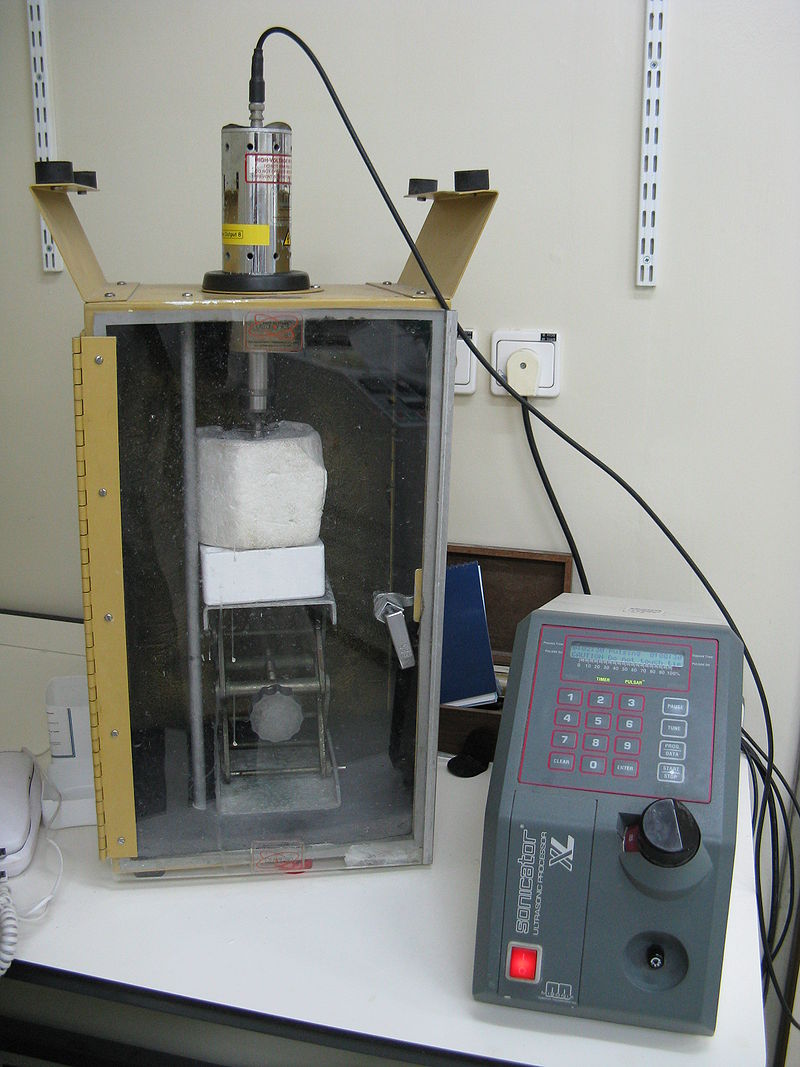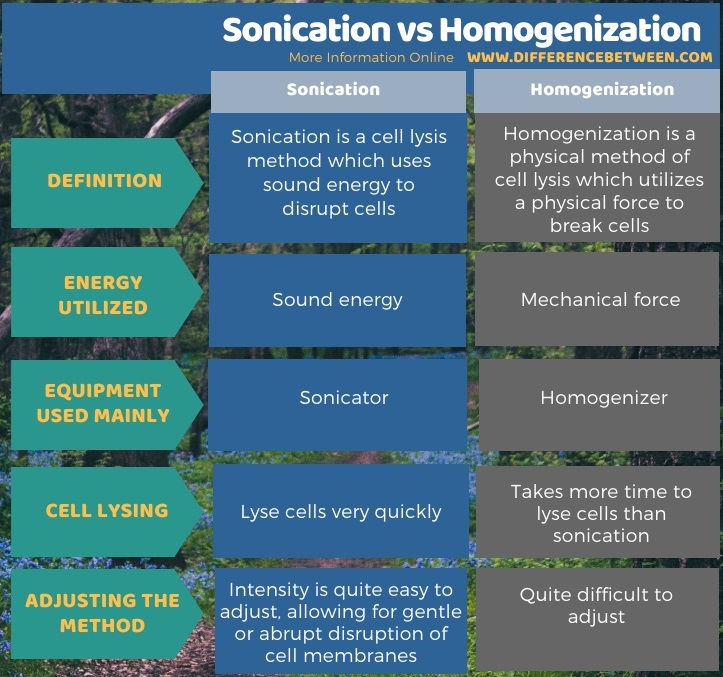Difference Between Sonication and Homogenization
Table of Contents
The key difference between sonication and homogenization is that sonication is a cell disruption technique which uses sound energy to disrupt tissues and cells, while homogenization is a cell disruption technique that mainly utilizes a physical force to break cell membranes.
In order to analyze biomolecules, their reactions and other cell contents, it is required to disrupt tissues to release cells and disrupt cells to release their contents. There are different cell lysis techniques. Sonication and homogenization are two such techniques. Sonication utilizes sound energy or ultrasonic waves to disrupt cells while homogenization utilizes mechanical force to disrupt cells.
CONTENTS
1. Overview and Key Difference
2. What is Sonication
3. What is Homogenization
4. Similarities Between Sonication and Homogenization
5. Side by Side Comparison – Sonication vs Homogenization in Tabular Form
6. Summary
What is Sonication?
Sonication is a cell disruption method in which high-frequency sound waves shear the cells. In other words, sonication utilizes sound energy to break cells. Similar to homogenization, sonication is also a physical cell disruption technique. Sonication is most effective in disrupting bacteria, yeasts, fungi, algae and mammalian cells. When high-frequency sound waves are applied, it generates a lot of heat. Hence, it is necessary to carry out sonication under cool conditions, especially immersing the sample in an ice bath. The sonication is best suited for the samples having volumes below 100 mL.

Figure 01: Sonication
Sonicator is the equipment used in sonication. Compared to other methods, cell lysis by sonication is fast and easy to manage.
What is Homogenization?
Homogenization is another physical cell disruption method which utilizes a mechanical force to break cells. Due to the force applied to cells and tissues, the cell membranes of the cells break. Mechanical homogenization, bead homogenization and grinding are several types of homogenization techniques.

Figure 02: Homogenization
In mechanical homogenization, a homogenizer is used. In bead homogenization, glass or metal beads are used to apply a gentle abrasion. In grinding, a motor and pestle are used. Moreover, in grinding, freezing the sample with liquid nitrogen is often done.
What are the Similarities Between Sonication and Homogenization?
- Sonication and homogenization are two methods used in cell disruption.
- Both methods are physical methods.
- Moreover, both methods are fast and easy.
- These methods are effective in disrupting bacteria, yeast, fungi, algae and mammalian cells.
- However, in both methods, protein denaturation and aggregation can occur.
- Moreover, reproducibility may vary in both methods.
What is the Difference Between Sonication and Homogenization?
Sonication is a cell lysis method that uses sound energy to disrupt cells while homogenization is a physical method of cell lysis that utilizes a physical force to break cells. So, this is the key difference between sonication and homogenization. Besides, sonicator is used in sonication, while homogenizer is used in homogenization.
Moreover, sonication lyses cells very quickly, while homogenization takes more time to lyse cells than sonication. Therefore, we can consider this also as a difference between sonication and homogenization. Furthermore, the intensity of sonication is quite easy to adjust, allowing for gentle or abrupt disruption of cell membranes, unlike homogenization.
Below infographic summarizes the difference between sonication and homogenization.

Summary – Sonication vs Homogenization
Sonication and homogenization are two physical cell disruption methods frequently used in laboratories. Sonication utilizes ultrasound waves to break cells while homogenization utilizes a mechanical force to disrupt cells. Thus, this is the key difference between sonication and homogenization. Sonication generates more heat than homogenization. Hence, it is necessary to carry out sonication under cool conditions. Moreover, sonication is best suited for the samples having less than 100 mL, unlike homogenization.
Reference:
1. Man, The Protein. “Cell Disruption Techniques: Sonication, Dounce Homogenizer & More.” Cell Disruption Techniques: Sonication, Dounce Homogenizer & More, Available here.
2. “Sonication.” Wikipedia, Wikimedia Foundation, 7 Feb. 2020, Available here.
Image Courtesy:
1. “Sonicator” By Eyal Bairey – Own work (CC BY-SA 3.0) via Commons Wikimedia
2. “Homogenizing valve” By Valvola_omogeneizzatrice.svg: Daniele Pugliesiderivative work: Daniele Pugliesi (talk) – Valvola_omogeneizzatrice.svg (CC BY-SA 3.0) via Commons Wikimedia
ncG1vNJzZmivp6x7pbXFn5yrnZ6YsqOx07CcnqZemLyue8OinZ%2Bdopq7pLGMm5ytr5Wau26%2FzqegnJmknryvecCnm2agn6K8qLHNorGarJmku3A%3D